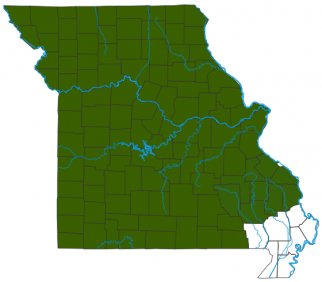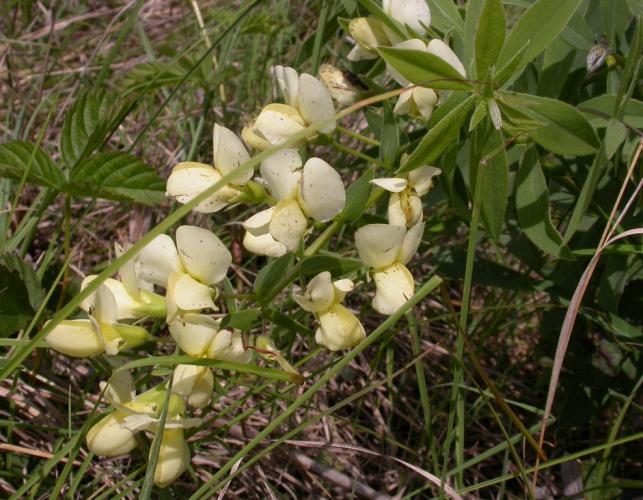
A low, bushy, sparsely to densely hairy perennial; our earliest-flowering Baptisia. Flowers many, in the typical pea-family shape, on a heavy, long, drooping raceme, cream-colored. Blooms April–June. Leaves with a pair of prominent leafy bracts (stipules) at the base; leaves compound with 3 leaflets, each to 3½ inches long, oblanceolate to narrowly obovate. Fruit an oval pod to 2 inches long with a pointed beak to ¾ inch long. Pod walls thick, leathery, somewhat hardened, with tiny, shiny seeds attached along one side within. Pods, and the rest of the plant, turn blackish upon drying.
Similar species: There are 4 species of Baptisia in Missouri. This one is distinguished by its large, persistent, leafy bracts at the bases of the compound leaves and the flower stalks; also by its hairiness, long flower stalks, and large fruits with tapering tips. It matures in late spring and flowers while the surrounding vegetation is still short.
Height: to 1 foot.

Statewide, except for the Southeast Lowlands.
Habitat and Conservation
Grows in rocky, open woods, upland prairies, glades, pastures, and fields, often along roads, in openings in woods, and along streamsides, usually on acid soils. Bitter alkaloid compounds in the foliage limit the use of Baptisia species as forage plants. Horses and cattle avoid it, although deer may sometimes eat the flowers. The presence of Baptisia plants is a good indicator of former prairies, glades, and savannas.
Human Connections
The foliage of Baptisia species has been used as a poor substitute for indigo in dyeing. The interesting oval seed pods can be used in dried flower arrangements. This plant is a good choice for native wildflower gardening, being hardy, heat and drought tolerant, and good for cut flowers.
Ecosystem Connections
The early-blooming flowers provide food for queen bumblebees when they emerge from winter hibernation, which helps get their colonies off to a good start; worker bees soon take over the foraging tasks. Several other bees, butterflies, and other insects collect nectar or pollen, or eat the leaves.

























